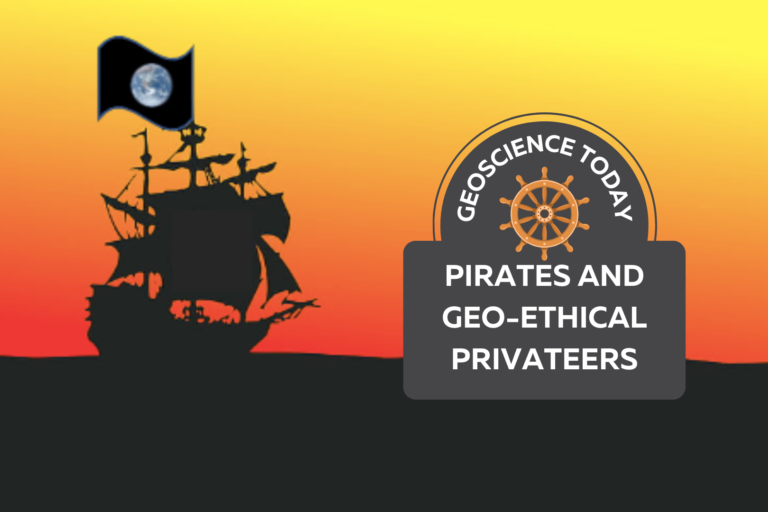By Paul Hubley, P.Geo.
“True Fact – the lack of pirates is causing global warming” – Forbes (2012)
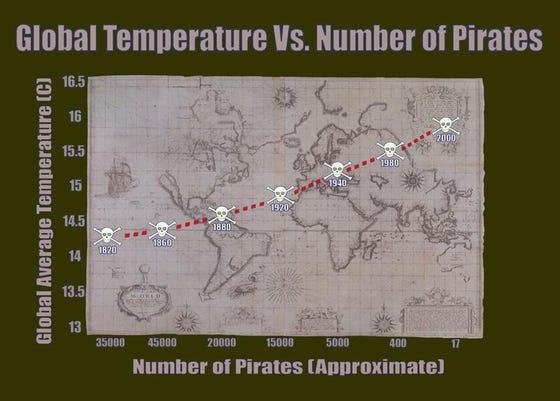
When Forbes Magazine published this graph along with the claim above, it caught my eye. In the graph, the average global temperature is increasing (on the vertical axis) as the number of pirates (on the horizontal axis) is decreasing. The reduction of pirates to “approximately” 17, roughly corresponding to the highest recorded temperature, is an oddly specific measurement (and my favourite part). There is even a handy timestamp along the curve and a familiar but outdated and partially obscured world map background for added authenticity. Taken together, the visual story woven by Forbes cleverly serves to reinforce some of our existing biases and our assumptions – it suggests that we need to pay attention as a society to this global issue of concern, that its all hands on deck concerning the increasing severity of the problem, its based on historical fact … and … global temperature rise is caused by an acute lack of pirates1.
Geoscience publications are usually not awash with correlations of Earth systems and the activities of pirates, so this raised a red flag. Though as perhaps you’ve guessed, the graph is “tongue-in-cheek”, challenging those purveyors of “fact” to not confuse simultaneity with causation, in other words, to ensure that we take due care to link measured effects to their causes. It reminds us that we have a collective responsibility to ensure integrity in our data, use applicable scientific methods, and provide unbiased reporting – to stand on our moral and ethical footings.
Broadly, morals are guiding principles, and ethics speaks to rules, behaviours or actions. The graph’s issues of data, methods and communication cause us to drift us into ethical territory. It is reasons such as this that geoscientists (and other professionals) have a Code of Ethics to abide by, usually focused on honesty, integrity in data collection, due consideration of uncertainty using scientific methods and employing unbiased interpretation (etc.).
Turns out that there is a Code for pirates too…
Context is Everything!
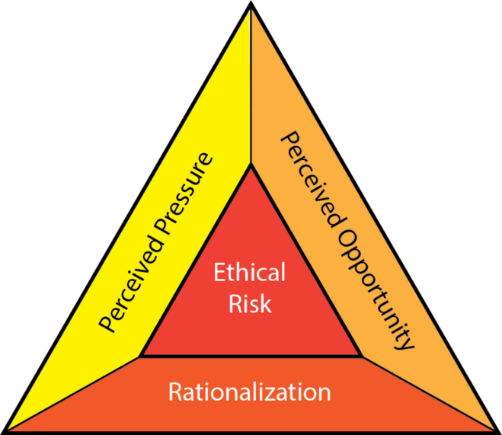
Pirates in the Elizabethan era (the Golden Age of pirates, provided you weren’t Spanish) had codes of conduct to keep harmony on the ship and align the objectives of the crew. Bartholomew Roberts Shipboard Articles of 1721 consisted of a number of agreements between the Captain and crew. The articles were necessary as pirates were not governed by any other rules such as Naval regulations. For some aspects (stealing from each other, gambling, etc.) the rules were very tight, but generally all bets were off once on shore. One of the more interesting elements was Article 9, that is if injury should befall a pirate while on the job, they would be paid a sum commensurate with their injury – in other words, they had a meaningful worker’s compensation program.
Pirate captains were elected and could lose their position for abuse of their authority. However, aside from the agreed articles, there wasn’t much elaboration on what constituted abuse of ethics. Using a modification of Cressey’s Fraud Triangle (Source: David Bailey, 2015 (adapted from Cressey, 1951)), it’s clear that pirates already had the pressure and opportunity to move them into ethical risk territory when a ship was sighted – the promise of riches and glory saw to that. The only thing holding a pirate captain back from ethical shark-infested waters was rationalization2.
But rationalization is a fickle passenger. At least, until society gets on board…

Canadian nautical society has a naughty history with piratical negotiations. Pirates receiving a Letter of Marque from the British Admiralty were thus commissioned as Privateers, notably during the War of 1812. These legal pirates were free to conduct their business provided their actions were aligned with the wider interests of society (i.e. the British Crown). One ship owner, Enos Collins, did rather well in 1812, becoming Canada’s wealthiest person; he also co-founded the Halifax Banking Company, a predecessor to the CIBC bank, using the spoils of privateering. If you’re in Halifax you can still see the oft-celebrated results of such shenanigans, starting at the Privateers Wharf (Sources: CIBC and East Coast Heritage. Photo by Thomas Goldsworthy Dutton via Wikimedia Commons).
It is social context that allows a scurvy scallywag to turn into a prizewinning Privateer, without fundamentally changing their behaviours. Societal expectations (in the example above, articulated by the Crown) provide the necessary rationalization to justify naughty behaviour.
On the other hand, the inspiration of society can increase the strength of winds in a positive direction, creating neo (new) ethical expectations for the betterment of society – this became evident in the 1970s when the “Blue Marble” was first hoisted3.
The Blue Marble Flag of the Earthship
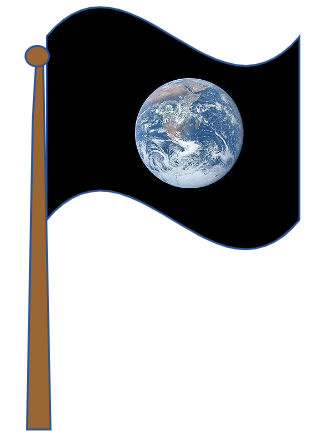
You have probably seen the Earth portion of this image without even noticing, as we take images like this for granted today. But it’s one of the most widely distributed print images in history. It was this NASA photo taken from Apollo 17 in 1972 that became the essential symbol of the public’s collective imagination and expectations. It was widely circulated in the 1970s as a symbol, or flag of the Earth’s fragility, representing vulnerability and isolation in the limitlessness of space, a tiny Earthship alone in the vast ocean. The implied message was, without better care, the Earth would be replaced with a skull and crossbones – society no longer accepted the wanton polluting of the environment, and this trend continues today. This example demonstrates that societal awareness may push to shore as might a sustained wind.
Notably, the photo was not the first of its kind – a few years earlier there were similar photos available from NASA – but earlier photos failed to capture society’s collective imagination like this one, because they were not connected to society’s collective anxieties and will (therefore = shifting winds).
And so for our voyage, it is the 1972 Blue Marble photo that is selected as our Earthship flag.
These days many of us are on deck looking about for routes toward the safe haven of sustainability for our Earthship. But to do that, we will need to use new navigational tools to gain other perspectives. Spilhaus shows the Earth in a new visual perspective, making it centred on the World Ocean. It takes a bit of effort to adjust our brains to the distortion that comes from taking a 3-D object being displayed in 2-D, but it’s a rather fun thought exercise for when you don’t have your Google Earth handy. I like the way this example includes both poles, emphasizes one (not five) oceans, and how it de-emphasizes the prominence of the land and brings more of the global south into central focus. You can be relatively sure that pirates knew full well that there was one World Ocean to navigate – it’s time the rest of us unbottled this perspective for ourselves.
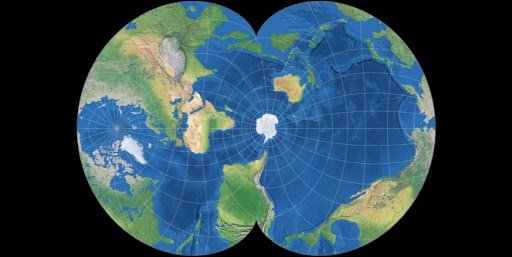

Placing pirates back in our societal sights again, perhaps we could change our Forbes graph to a chart of awareness of global temperature instead of temperature alone. Further, some pirates, perhaps through curiosity or some wave of morality, may even hang up their cutlasses and agree to sign up to provide some valuable observations to the goings-on during travels of the World Ocean, much the way citizen science is providing data that otherwise would be unavailable through scientific study. In order to involve the more barnacled of pirates (barnacles are animals excreting calcareous crusts, like corals, that increase the drag on ships) to help reach the safe haven, perhaps we’ll need some additional rationalization as was done by the British Crown – perhaps we can commission would-be pirates as neo-Privateers. Crews could be mobilized to fish plastic waste out of the water as they sail the Ocean Blue; then they could make feedstock out of the waste and operate 3-D printers at port or on the ships to convert the waste to useful products that they can use to barter for coin or other shiny objects back at shore. So when the neo-Privateers are out on the water you’ll see signs about town saying “gone plasticking”.

On land or sea (or outer space … or Middle Earth), geoscientists are more than just aligned with the interests of society, we are primarily at the service of society – this is the deeper purpose of our activity. And it is society that has the keys to the treasure chest, though sometimes doesn’t know it, and keys get misplaced, and awareness lags behind, and something catches society’s eye and people get distracted for awhile, etc.
It should be noted that popular culture often blames mischievous monkeys for misplaced keys – but that’s just one-eyed seeing (i.e. a narrow perspective). We’ll all be better off if we take personal and professional ownership of our positions and try to refrain from scolding monkeys simply for doing what they enjoy and what they’re good at.
So, even pirates can be repurposed to meet society’s evolving ethical expectations for the Earth System, given the right rationalization. All this with minimal mutiny if sufficient care is taken that the rationalization is not an anchor too big for the ship.
Looking out to the horizon, we may see that if ethics are going to stay legitimate, they need to reflect the society they serve. They need to be a reflection of society’s collective conscience, will, and inspirations – to develop geo-ethical Privateers, of sorts. As an attempt to stay legitimate, an Earth system-centric concept of ethics was recently proposed to do just that …
Geoethics
The term Geoethics is described in the Cape Town Statement on Geoethics (2016). Geoethics consists of research and reflection on the values which underpin appropriate behaviours and practices, wherever human activities interact with the Earth system. It’s based on central tenets of (i) individual accountability and (ii) scientific knowledge. Geoethics is a term that reflects an international consensus on ethics, aiming to capture the attention of those that work in the Earth system. Geoscientists can now welcome aboard the Geoethical Promise, a Hippocratic-type oath, as proposed in the Cape Town Statement On Geoethics, which reads:
I promise…
…I will practice geosciences being fully aware of the societal implications, and I will do my best for the protection of the Earth system for the benefit of humankind.
…I understand my responsibilities toward society, future generations and the Earth for sustainable development.
…I will put the interest of society foremost in my work.
…I will never misuse my geoscience knowledge, resisting constraint or coercion.
…I will always be ready to provide my professional assistance when needed, and will be impartial in making my expertise available to decision makers.
…I will continue lifelong development of my geoscientific knowledge.
…I will always maintain intellectual honesty in my work, being aware of the limits of my competencies and skills.
…I will act to foster progress in the geosciences, the sharing of geoscientific knowledge, and the dissemination of the geoethical approach.
…I will always be fully respectful of Earth processes in my work as a geoscientist.
I promise!
The Geoethical Promise is already being used during the ceremony marking new Master’s recipients in Italy, and it is expected to spread.
The Geoethical Promise is not a Letter of Marque or an Article of agreement, at least not yet, nor is it proposed as a rule or a veto right. It is an expectation for professionals to have a healthy respect for the rules of engagement of their activities, understanding the laws, regulations, Code and guidelines. It includes an implicit expectation that a(ny) person (there is current discussion whether or not this should be limited to only professional geoscientists or should include all practitioners in the Earth System) will take the opportunity to shout out from the crow’s nest when they see the Earthship heading toward the rocky shoal.

Just as with the pirates-turned-neo-Privateers there is no shortage of work for Geoethical Privateers: the deck will have to be swabbed of the way we’ve always done things; the sails will need to be managed to catch the new winds of a transition society – inclusion, equity, diversity, calls to action, calls to justice, new ways of knowing, and deeper respect of the Earth system and its stewards; and the Earthship’s course will need to be set toward sustainability and effective risk management, given that people are the key actors of the Earth system in the Anthropocene. Geoethical Privateers can be key parts of the crew for all of these voyages.
Setting the Sails
“It’s not how the wind blows, it’s how you set your sails”, my Aunt Florence would say, referencing her fathomless experience in matters of sailing (fathomless: deep, unable to know fully). The Geoethical Promise reflects a choice to reset the sails, anchored in geoscience but relevant to everyone on the Earthship.
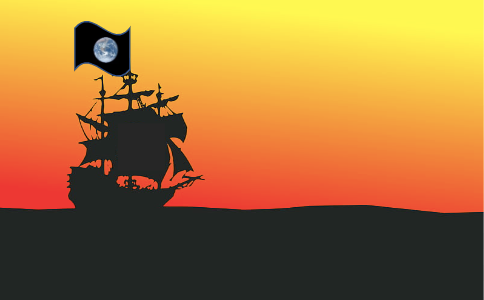
Sunset
On our voyage in the World Ocean we have observed pirates, Privateers, neo-Privateers, and even geo-Privateers. As the sun sets on this day and we think about tomorrow we see the chart having more relevance – with awareness added to the vertical axis and recruitment providing more hands on deck on the horizontal axis, it should be possible for the Earthship to sail to better outcomes. The answer to global warming awareness, at least in part, may depend on having more Geoethical Privateers.
Having more hands on deck should also result in finding more creative ways to distract the naughty monkeys away from the keys.

1Forbes and the rest of us can be a bit cheeky with this as long as we assume that the pirate is the romantic and completely unrealistic pirate stereotype such as in popular movies (and not the white collar variety, or actual conditions at sea), so we’ll stick with this fantasy too, as it serves our purposes.
2 The term is a misnomer – sharks are necessary for a healthy ocean ecosystem and require due respect.
3 Similarity of Black Pearl to Blue Marble may be a coincidence, or not…

Paul Hubley is a Professional Geoscientist, Canadian Risk Manager, Co-Coordinator (Canada) for the International Association of Promoting Geoethics (IAPG), People and Policies Coordinator for Geology for Sustainable Development, Professional Geoscientists Ontario (PGO) Past President and Chair of the PGO Professional Practice Committee; at PGO, Paul has been involved with the refinement of various codes and guidelines. He was born in Halifax, Canada’s former pirate capital. He had a student loan with the CIBC…but paid it back.

